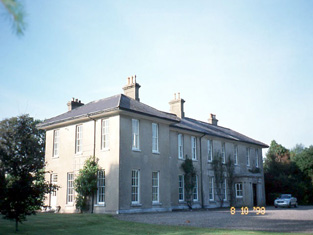Churchtown
Houses within 5km of this house
Displaying 10 houses.
Houses within 5km of Churchtown
Displaying 10 houses.
| House name | Description | |
|---|---|---|
| The Reeks or Baunclune | The McGillycuddy was in possession of the property at Whitefield at the time of Griffith’s Valuation when it was valued at £24 10s. Lewis and Leet also refer to Whitefield as a seat of The McGillycuddy in 1837 and 1814 respectively. Leet, however, also notes McGillycuddy Reeks as the address of McGillycuddy esq. In 1906 it was McGillycuddy property and valued at £24. Bary states that the house was originally known as The Reeks after the family title but that it was changed to Whitefield in the early 19th century by Richard McGillycuddy. However, on both the 1st and 25-edition Ordnance Survey maps it is labelled Baunclune. In more recent times it is known as The Reeks. This is how it is referred to by the Irish Tourist Association surveyor in the early 1940s who states that it was the the home of "Ross Kinloch, the MacGillycuddy of the Reeks and a member of Seanad Eireann". The house is still extant and occupied. |

|
| Grenagh House | Denis Lawlor was leasing Grenagh House from Henry Herbert’s estate at the time of Griffith’s Valuation when it was valued at £23 15s. Lewis mentions Grena as the seat of John O’Connell in 1837. The Ordnance Survey Name Books indicate that it was built by Mrs. Delaney in 1792. Bary states that O’Connell was obliged to leave the house due to debts. It then came into the possession of Denis Shine Lawlor and later again, Daniel James. It was afterwards the property of the O'Connor family but has been ruinous since the mid twentieth century. | |
| Ballymalis | Christopher Gallway was leasing a property from John Sealy, which included a mill, at Ballymalis at the time of Griffith’s valuation. It was then valued at £34. It is labelled "paper mill" on the 1st edition Ordnance Survey map and as "woollen mill" on the 25-inch edition of the 1890s. An extensive range of buildings still exists at the site. Elsewhere in this townland is Ballymalis Castle, a tower house in existence since the sixteenth century and latterly, associated with the Eager family. | |
| Beaufort | Reverend Edward Day was in possession of the house at Beaufort at the time of Griffith’s Valuation when it was valued at £37. Lewis refers to it as the seat of Frederick W. Mullins in 1837. In 1814 Leet also refers to it as the residence of Reverend F. Mullins. In 1786 Wilson refers to Beaufort as the seat of Hon. Dean Crosbie. Various sources, including Bary, indicate that it was built on the site of a tower house known as Short Castle. . It was sold by the Mullins estate in the mid nineteenth century to the Day family who sold it again in the 1880s. Referred to by Slater in 1894 as the seat of Lt-Col. E. Nash Leahy. It is still extant and occupied. |

|
| Cullenagh House | At the time of Griffith’s Valuation, Cullenagh House was occupied by Kean Mahony when it was valued at £22. Lewis records it as the seat of Kean Mahony in 1837 as does Leet in 1814. In 1906 it was the property of Thomas McDonagh Mahony and valued at £18. Bary states that this house was probably built by the Mahonys towards the end of the 18th century. It was still extant but uninhabited towards the end of the twentieth century. | |
| Cullenagh Lower | Myles Mahony was occupying a house at Cullenagh Lwr at the time of Griffith’s Valuation. It was valued at £6 and part of a holding of 176 acres. The house is not shown on thre 25-inch Ordnance Survey map of the 1890s. | |
| Dunloe Castle | At the time of Griffith's Valuation, Daniel Mahony was leasing Dunloe Castle from Thomas H. Broderick when it was valued at £15. Lewis describes it as formerly the seat of the O’Sullivan family but in 1837 the residence of D. Mahony. Leet refers to it as the residence of Daniel Mahony in 1814. Wilson, writing in 1786, mentions Dunloe Castle as the seat of Gustavus Crosbie. In 1894 Slater refers to it as the seat of John Mahony. The Irish Tourist Association surveyor notes that this property has associations with the United Irishmen and states that, in the early 1940s, it was owned by Agnes Petitt. Bary states that it remained in the Mahony family until the mid-20th century. The castle itself is now a ruin, located in the grounds of the Dunloe Castle Hotel. | |
| Gortnaskarry House | At the time of Griffith’s Valuation, Michael Horgan was leasing a property at Gortnaskarry valued at £5 from the representatives of Denis Mahony. Bary speculates that it may once have been an inn. It is still extant. | |
| Gortnaskarry Cottage | Colonel Drummond was leasing a property valued at almost £5 to John Breen at the time of Griffith’s valuation. It is labelled Gortnaskarry Cottage on the 1st edition Ordnance Survey and remains by this name on subsequent editions.A house and farm are still extant at the site. | |
| Tomies | In 1837 Lewis mentions Tomies as the seat of D.J. O'Sullivan. At the time of Griffith's Valuation, the property, valued at £5, was being leased by Daniel O'Sullivan from the Herbert estate. Bary states that this house was more usually associated with the O'Donoghue estate, citing references to "O'Donoghue of Tomies" in the local press. In 1906 Lord Ardilaun owned the property at Tomies East valued at £8 15s. It is now in ruins. |

